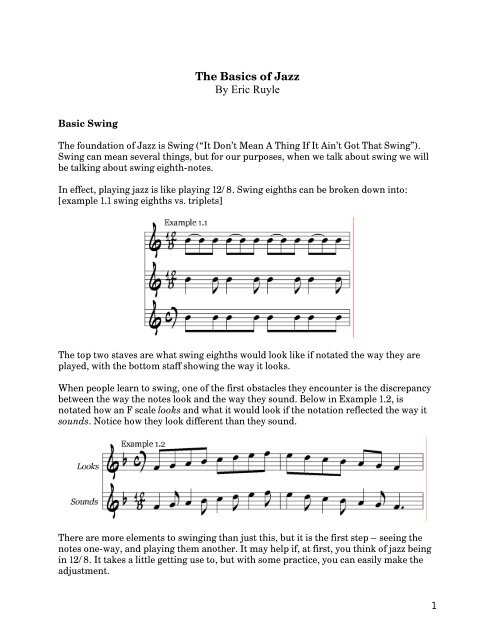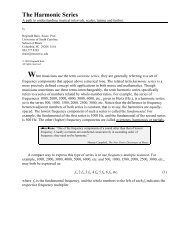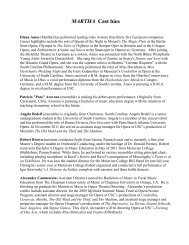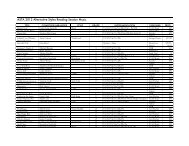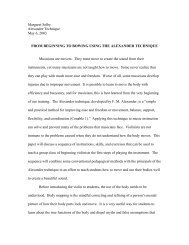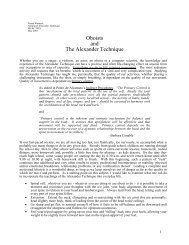Create successful ePaper yourself
Turn your PDF publications into a flip-book with our unique Google optimized e-Paper software.
Basic Swing<br />
<strong>The</strong> <strong>Basics</strong> <strong>of</strong> <strong>Jazz</strong><br />
<strong>By</strong> <strong>Eric</strong> <strong>Ruyle</strong><br />
<strong>The</strong> foundation <strong>of</strong> <strong>Jazz</strong> is Swing (“It Don’t Mean A Thing If It Ain’t Got That Swing”).<br />
Swing can mean several things, but for our purposes, when we talk about swing we will<br />
be talking about swing eighth-notes.<br />
In effect, playing jazz is like playing 12/8. Swing eighths can be broken down into:<br />
[example 1.1 swing eighths vs. triplets]<br />
<strong>The</strong> top two staves are what swing eighths would look like if notated the way they are<br />
played, with the bottom staff showing the way it looks.<br />
When people learn to swing, one <strong>of</strong> the first obstacles they encounter is the discrepancy<br />
between the way the notes look and the way they sound. Below in Example 1.2, is<br />
notated how an F scale looks and what it would look if the notation reflected the way it<br />
sounds. Notice how they look different than they sound.<br />
<strong>The</strong>re are more elements to swinging than just this, but it is the first step – seeing the<br />
notes one-way, and playing them another. It may help if, at first, you think <strong>of</strong> jazz being<br />
in 12/8. It takes a little getting use to, but with some practice, you can easily make the<br />
adjustment.<br />
1
Keeping swing smooth is very important for several reasons. First, fluidity is needed to<br />
help propel the lines. It is easier to play fast lines when things are smooth. Second, it<br />
creates a striking contrast when angularity is added through the melodic line.<br />
Practice all your scales in swing style, slurring them as you play. [Example 1.3] Slurring<br />
will help keep the rhythm smooth, which is essential and will be discussed further in the<br />
next chapter. <strong>The</strong> goal is to make it sound and feel natural. Also, playing scales with a<br />
swing feel is a great change <strong>of</strong> pace when practicing!<br />
Listening to the drums, specifically the ride cymbal, will help when playing. A good<br />
drummer makes swinging easy by giving you a good swing feel. <strong>By</strong> focusing and<br />
matching the feel <strong>of</strong> the rhythm section will help you keep things relaxed.<br />
Bebop Tonguing<br />
If you’ve experimented with swing eighths, you noticed that while it sounds okay,<br />
something is missing. It is this point that separates the hip from the others. This is also<br />
where misleading information can occur.<br />
One <strong>of</strong> the biggest misconceptions is that in order to swing, you should put accents on<br />
every up-beat.<br />
<strong>The</strong> notes are in the swing style, but it does not sound quite right. All the accents<br />
unfortunately destroy any smoothness that you create. So, it is not right with the<br />
accents, but it is not right totally slurred: something is left out.<br />
2
What is absent is Bebop Tonguing. Put simply, the key to swinging authentically is<br />
Bebop Tonguing. In Bebop Tonguing, you tongue the upbeat and slur to the downbeat.<br />
[Example 2.2] This style <strong>of</strong> articulation is not notated in the music; the player is<br />
expected to know to use Bebop Tonguing automatically. Because <strong>of</strong> its importance and<br />
“secretive” nature, you could consider Bebop Tonguing one <strong>of</strong> the secrets <strong>of</strong> <strong>Jazz</strong>.<br />
When applying the slurs you have to be carefully not to make the ends <strong>of</strong> them (the<br />
downbeats) short. While this may be common in classical music, it is not appropriate for<br />
jazz. In order to keep the smoothness needed for swing, the downbeats need to be<br />
legato.<br />
One way to keep things in perspective is to re-examine swing eighths. Look back at the<br />
two notes <strong>of</strong> a beat in example 1.1. Notice that relationship: the downbeat is twice as<br />
long as the upbeat. This is a good reminder to keep the ends <strong>of</strong> the slurs long.<br />
Along with the misguided accents, the other common mistake is to clip the ends <strong>of</strong> the<br />
slurs. When the ends <strong>of</strong> the slurs are played short, it causes the swing to sound “hokey.”<br />
Since we try to keep things smooth, the tongue on the upbeats creates a contrast, which<br />
is <strong>of</strong>ten mistaken for accents. <strong>The</strong> effect <strong>of</strong> Bebop tonguing should just be an<br />
interruption <strong>of</strong> the legato line. When practicing Bebop tonguing, slur the whole passage<br />
first then add the tongue on the repeat: the two should sound and feel very similar.<br />
Remember, there should be no difference in the air-stream between slurring and Bebop<br />
tonguing.<br />
Bebop tonguing even applies to pieces where everything is slurred. <strong>The</strong>re was a period<br />
when publishers marked everything to make sure that the passages were played legato<br />
and smooth.<br />
Once you are comfortable with swing and Bebop tonguing, try using it with other scales<br />
and music – it is a great way to have fun!<br />
Rules <strong>of</strong> <strong>Jazz</strong><br />
As jazz evolved through time, there developed certain “rules” to how jazz should sound.<br />
<strong>The</strong>se rules were not written down or stated in any fashion. Players learned them by<br />
3
listening and mimicking other players. <strong>The</strong>se stylistic idiosyncrasies create what I call<br />
“<strong>The</strong> Rules <strong>of</strong> <strong>Jazz</strong>.” As with bebop tonguing, these are not generally marked in the<br />
music; it is expected that the player is familiar with these. <strong>By</strong> following these guidelines,<br />
you will be on your way to sounding and playing like a true jazz player!<br />
Since jazz was not written down, but passed down aurally, not all players will employ all<br />
<strong>of</strong> the rules. In fact, due to the wide variance in individual playing styles and<br />
interpretations, there are some that do not follow any <strong>of</strong> the rules. It is these differences<br />
in approach that make jazz so personal and exciting! But, by employing these guidelines,<br />
you will be able to blend in and play in any setting.<br />
Rule #1: All Eighths are legato unless marked otherwise.<br />
This goes back to the idea that swing needs to be smooth. <strong>By</strong> playing all eighths long,<br />
this eliminates any “hokeyness.” Proper use <strong>of</strong> Bebop Tonguing helps keep things<br />
smooth. Play through Example 3.1, making sure to keep things legato. If you are having<br />
trouble with keeping things smooth, go back and slur the passage to reacquaint yourself<br />
with how it sounds legato.<br />
Playing jazz should feel easy. If it seems uncomfortable, focus on keeping things legato.<br />
Generally, if you make things smooth and legato (especially if you are using Bebop<br />
Tonguing), everything will be okay.<br />
If the composer/arranger wants to make an exception and have the eighths short, they<br />
will mark it in the part (finally, something notated!) to make sure there is no<br />
misunderstanding. (This pertains to our friend UMO – Unless Marked Otherwise)<br />
Rule #2: All Quarter Notes are Short UMO (unless marked otherwise).<br />
Similar to all eighths legato, all quarter notes are short. Short in <strong>Jazz</strong> is not the same as<br />
short in Classical. In Classical short means “as short as possible,” where as in <strong>Jazz</strong> it<br />
means “shorter than normal but with weight or attitude.”<br />
<strong>The</strong> syllable used for short notes is “Daht.” Notice how “Daht” has weight to it, yet it<br />
does not give the note full value. Compare this syllable with its use <strong>of</strong> the s<strong>of</strong>ter<br />
beginning “D” to the more percussive attack <strong>of</strong> the Classical “T” (Ta, Tut, etc.). When<br />
playing short notes, use the syllable in order to give the note its proper weight and<br />
length. I like to think <strong>of</strong> short notes as “Big Bertha Notes” – lots <strong>of</strong> attitude, nothing<br />
wimpy or pristine about them.<br />
4
This rule applies to all notes equal to a quarter note in length; ties across the bar/beat<br />
are included. Pay particular attention to ties across the bar equaling a quarter note, they<br />
are commonly overlooked.<br />
Be careful not to rush the beat when playing quarter notes – the tendency is to speed<br />
things up because <strong>of</strong> the empty space created by playing the notes short. Be vigilant<br />
about keeping solid time/tempo. (Or as jazzers say, “keep it in the pocket.”)<br />
Similar to Rule #1 and eighth notes, when the composer/arranger wants something<br />
other than short quarter notes, they will mark it in the part. (This would be the MO in<br />
UMO)<br />
Rule #3: All notes followed by rests are short UMO<br />
In order to create angularity (which is needed in the middle <strong>of</strong> all the smooth eighths),<br />
jazzers use short notes. We have learned that this pertains to quarter notes, but it also<br />
applies to all notes followed by rests. Yes, even eighth notes.<br />
While this seems to contradict Rule #1, it is overruled by the fact that by making these<br />
particular notes short, we create angularity. It is this contrast between smooth and<br />
angularity that make jazz so fascinating.<br />
Usually, phrases that stop on the beat will do so with quarter notes, and phrases that<br />
end <strong>of</strong>f the beat, on the upbeat, use eighth notes.<br />
Be sure to keep using (Big Bertha) “Daht” for your short notes.<br />
Rule #4: Accent all ties<br />
In order to give ties a sense <strong>of</strong> direction, accent them. When dealing with ties, be sure to<br />
distinguish those ties that equal a quarter note between those with a value longer than a<br />
quarter note. If the tie equals a quarter note, refer back to rule #2.<br />
5
While it depends on the music, not only do you accent ties but also a<br />
crescendo/decrescendo. This falls under the heading <strong>of</strong> general musicianship.<br />
<strong>By</strong> crescendoing the notes, you give the melodic line momentum.<br />
Rule #5: Triplets and Sixteenths are slurred UMO<br />
Triplets and sixteenths always present a problem for jazz beginners. Since the music is<br />
not generally marked properly, diligent students will attempt to tongue the individual<br />
notes for the triplets and sixteenths. This not only breaks the good swing feel, but can be<br />
very difficult to accomplish when the tempos are fast. (Imagine trying to tongue<br />
sixteenths when the tempo is 230!)<br />
What we end up doing (again with the jazz secrets) is slurring triplets and sixteenths,<br />
even though they are not marked that way. Of course, our friend UMO still applies.<br />
If the triplet/sixteenth grouping is preceded by an upbeat eighth-note, be sure to include<br />
the grouping with the bebop tonguing.<br />
Bebop tonguing also applies to eighth notes after the grouping.<br />
If there is some articulation marked in the triplets or sixteenths, it is generally in<br />
conjunction with a slur (slur two- tongue the next, etc). As always, slurring keeps the<br />
smoothness <strong>of</strong> the swing.<br />
Quarter notes after the grouping do require a tongue, in order to give the proper “Daht”.<br />
Conclusion<br />
Playing jazz can seem a daunting task with many unnotated elements. As we have seen,<br />
it is as simple as applying Bebop tonguing and following five simple rules. Using these<br />
will demystify the idiosyncrasies <strong>of</strong> jazz. <strong>By</strong> following these guidelines, you can blend in<br />
any situation and will be on your way to sounding and playing like a true jazz player!<br />
6


